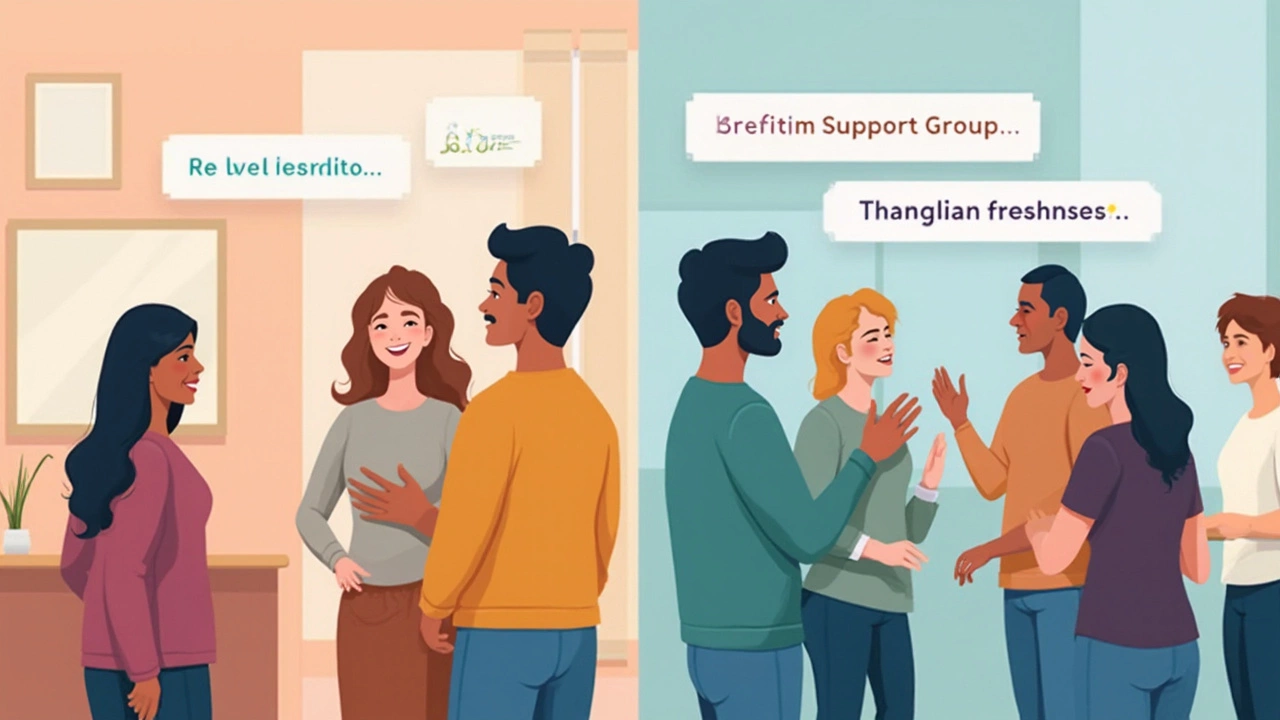Are Support Groups Worth It? What Really Happens Behind Closed Doors
 Apr, 28 2025
Apr, 28 2025
So, is sitting in a circle with strangers and sharing your story really worth your time? You might be surprised at what actually happens in local support groups—no tissue boxes and dramatic confessions required. The truth is, support groups come in all shapes and sizes, and they’re not all run by professionals. Some are tight-knit gatherings at a neighbor’s house; others meet in church basements or even online. It’s not group therapy—think more like a bunch of people who “get it,” all there for the same reason: nobody wants to feel alone in their mess.
If you think support groups are just for people with big, obvious problems, that’s not true. People join for everything from addiction recovery to parenting stress, chronic illness, grief, or just plain old anxiety. What’s consistent? Members help each other out, swap advice that worked for them, and sometimes just listen without judging. Unlike chatting with friends or family, these folks actually understand what you’re going through.
- What Support Groups Really Offer
- How People Actually Benefit
- Common Misconceptions Busted
- Tips for Finding the Right Group
- Making Your First Meeting Actually Work
What Support Groups Really Offer
Walking into a support group isn’t about getting a lecture or a therapy session—it’s way more hands-on. At its core, every support group offers a simple thing: real people listening, sharing, and showing up for each other. Most of the time, these meetings are low-key, honest, and focused on everyday challenges. You don’t have to bring anything but yourself. No one keeps score, and nobody forces you to talk.
Here’s what you’ll actually find in a typical local support group setting:
- Peer Support: Everyone in the room gets what you’re dealing with because they’ve been there—or they’re still in it. You get advice from people who have tried things, failed, and tried again, not just experts with a clipboard.
- Shared Tips & Resources: Members often swap info on what treatment, apps, or routines actually help, saving you endless internet searches or guesswork. Sometimes people even bring handouts or links to local services that others might not know about.
- Safe, Judgment-Free Space: You can speak honestly without worrying someone’s going to roll their eyes. A recent 2023 survey by Mental Health America showed 71% of folks in support groups felt less judged compared to talking with family or friends.
- Regular Check-Ins: Many groups meet once a week or biweekly, which means you always have a place to check in, vent, or celebrate a small win.
The coolest part? You don’t need a referral or diagnosis to walk in. It’s okay if you just want to listen at first. And yes, most support groups are either free or ask for a tiny donation to cover snacks or a room rental.
| Reason for Joining | Percent of Respondents |
|---|---|
| Want to feel less alone | 56% |
| Looking for practical advice | 48% |
| Need regular encouragement | 37% |
| Tired of judgment from others | 24% |
So when you hear "support group," don’t picture a bunch of sad people just airing problems. Think about practical tools, a sense of belonging, and sometimes, the only group in your life that fully gets what you’re up against.
How People Actually Benefit
People join support groups hoping for help, but the real benefits often go beyond what most expect. Study after study backs this up. For example, according to a survey from Mental Health America, almost 70% of folks in peer support say the biggest change is finally feeling understood—something therapy alone doesn’t always nail. There's a reason even hospitals, like Cleveland Clinic, send patients to group meetings for chronic illness and post-surgery support. Sharing tips and stories face-to-face can make doctor’s advice much easier to follow in real life.
Here’s how local support groups actually help people:
- Less isolation, more connection: It’s one thing to read about coping with anxiety or grief online, but another to sit across from someone who’s been there. That connection really cuts through loneliness, which can make any struggle feel a lot heavier.
- Real talk from real people: You’ll hear about tricks, hacks, and advice that don’t show up in textbooks. Ever heard a doctor talk about weird side effects in plain English? Members in these groups will.
- Accountability that actually works: It’s harder to back out on goals—like staying sober or sticking with treatment—when real people are waiting to hear how it went.
- Confidence boost: When you give advice or just listen, you’re not just taking, you’re giving. That makes people feel useful, not just needy.
- Cost (almost always free): Most local support groups cost nothing or just a small donation for snacks or space. Compared to a $150 therapy session, that’s a relief.
Check out some quick stats that keep popping up in research:
| Benefit | % Reporting It |
|---|---|
| Feel less alone | 72% |
| Learn practical tips | 64% |
| Stick with healthy habits | 55% |
| Save money | 48% |
Even the simple act of showing up can shake off some of that feeling of helplessness. When you realize others have faced your exact struggle—and made it to the other side—you start believing you can, too.

Common Misconceptions Busted
Let’s clear up some stuff people always get wrong about support groups. First, a lot of folks think these meetings are only for people hitting rock bottom, but that’s way off. In reality, everyone from new parents to teens with anxiety walks into local support groups looking for answers or just to feel heard. There isn’t a “bad enough” level required to show up.
Another myth? That you have to spill your deepest secrets on day one. Nope. Most groups are 100% cool if you don’t want to talk at all, especially in the beginning. Just listening often helps more than you’d guess. You don’t have to perform, and nobody’s taking attendance on how much you share.
Lots of people assume these are therapy sessions run by doctors or counselors, but that’s rare. Most groups just have organizers—not licensed pros—who are regular people like you. If you’re after mental health treatment, look somewhere else, but if you want friend-style support, this is it.
Some think everything is super somber or negative. Actually, plenty of groups mix in laughter, ordinary life stuff, and even snacks. People talk about wins as much as setbacks. It’s not just about problems; it’s about support, peer support, and connections.
And if you’re worried about privacy, here’s a quick look at what’s typical among neighborhood support groups:
- Most have clear ground rules about confidentiality—what’s said in the room, stays in the room.
- Nobody is pressured to give their full name or details.
- You can leave anytime without awkward questions.
For some real numbers, a study published by Mental Health America in 2023 found that 62% of members reported feeling less alone after one month of regular group meetings. That’s a huge boost for anyone considering taking the leap.
Tips for Finding the Right Group
Not all support groups are created equal, and the fit matters. Feeling out of place is a quick way to lose motivation to go back. Here’s how to score a group that actually helps instead of leaving you more stressed.
- Decide what you need: Are you looking for practical help, emotional support, or a mix of both? Some groups are strictly about education or skills (think parenting or chronic illness), while others lean into sharing and venting. Check out group descriptions or ask the organizer specifically.
- Be picky about the vibe (not just the topic): Don’t settle if you walk in and click with no one. The best local support group for you is one where you feel safe just being yourself—even if you’re a mess that day.
- Look for real experience, not just credentials: Peer-led groups (run by people going through it themselves) are sometimes more relatable than ones with a professional facilitator. Try both and see what feels right.
- Try before you buy (or commit): Most groups let you sit in a couple of times for free. You’ll get a sense of what’s normal and if the format works for you—some are open discussion, others stick to strict time limits.
- Check logistics: If a meeting’s time or location is a hassle, even the perfect group therapy session won’t help if you never make it. Many local organizations, like the National Alliance on Mental Illness (NAMI), list virtual and in-person groups by zip code.
Still not sure if you’ve found the right place? Take a peek at why people drop out of groups, according to a 2023 survey of over 1,000 U.S. participants.
| Dropout Reason | Percentage |
|---|---|
| No connection with other members | 38% |
| Didn’t feel safe sharing | 24% |
| Meetings were inconvenient | 20% |
| Group not helpful for my issue | 13% |
| Other | 5% |
Bottom line: Give a group two or three tries before making up your mind. Your comfort is key—and swapping stories with the right people can make all the difference.

Making Your First Meeting Actually Work
Your first time at a support group can feel awkward. Seriously, even people who talk all day at work can go silent when it comes to sharing something personal. Here’s the thing: You don’t have to share at all if you’re not ready. Most local support groups are set up so you can just sit and listen. That’s normal—and sometimes it’s the best way to start.
If you decide this is your moment to speak, keep it simple. You don’t have to spill your entire story. Try saying your name and a line or two about why you came in the first place. Most people in the group remember exactly what their first time was like, so you’re not going to get judged for being nervous.
- Arrive a few minutes early. It takes off some of the edge, and usually there’s someone friendly who’ll help you settle in.
- Scope out the group. Some meetings are focused on listening, some on group advice, others on education. If the style isn’t a fit, it’s totally fine to try another one.
- Don’t fake it. If you’re uncomfortable, it’s okay to just listen or say “I’m just here to see what this is about.”
- Take note of the ground rules. Most places have a quick intro to guidelines—like confidentiality, taking turns, and no interrupting.
According to Mental Health America, over 70% of people say they felt less isolated after attending their first support group—even if they didn’t talk. Check this out for more practical confidence:
| Tip | Why it helps |
|---|---|
| Bring a notebook | Jotting down useful advice beats relying on memory, especially if you’re stressed |
| Set a small goal | Try to talk once or introduce yourself, and don’t force more than you want |
| Follow up | If someone’s advice clicked, ask about more resources after the meeting |
Remember, nobody expects perfection. The hard part is just showing up. Most group regulars wish they’d started sooner, and people new to peer support usually realize pretty fast they’re not alone in what they’re dealing with.